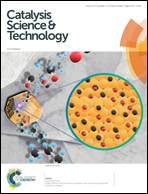Mechanism of SAPO-34 catalyst deactivation in the course of MTO conversion in a slurry reactor†
Abstract
The deactivation of a SAPO-34 catalyst in the course of the methanol-to-olefin conversion has been studied in a slurry reactor in polydimethylsiloxane medium and compared with that in a fixed-bed reactor. The carbonaceous deposits accumulated on the catalyst have been investigated by thermo-gravimetric analysis, UV/vis and fluorescence spectroscopy, the MALDI-TOF technique and GC/MS analysis after dissolution of used catalysts in hydrofluoric acid and extraction of coke with dichloromethane. The results show that under slurry conditions the catalyst deactivation is much faster than under fixed-bed conditions. The main reason for the fast deactivation is the accumulation of olefinic products on the catalyst/polydimethylsiloxane boundary due to their high solubility in polydimethylsiloxane. The proposed mechanism involves the interaction of olefins with aromatic compounds formed at the outer surface and in the pore mouths of the catalyst crystals leading to polyaromatic products, which block the entrances to the pores and prevent further reaction. It has been demonstrated that the stability of the catalytic activity with time on stream can be improved by decreasing the N2/CH3OH molar ratio in the flow and by selective poisoning of Brønsted acid sites at the outer surface of the crystals. The results obtained show the way for further improvement of catalytic performance in a slurry reactor.



 Please wait while we load your content...
Please wait while we load your content...